Note to readers: back in the formative days of model engineering, a dispute broke out between Henry Greenly, who had virtually invented the modern model railway, and Lillian Lawrence ('LBSC') over the which was the best type of boiler for model locomotives. This disagreement became known as the "Battle of the boilers", perhaps after a similar episode that galvanised engineering officers in the Royal Navy in the 1890's regarding the merits of water tube vs. fire tube boilers for warships. The model dispute came to a head in 1924 when LBSC went head to head with Greenly and Bassett Lowke at that year's Model Engineering Exhibition. LBSC firmly established the superiority of the firetube boiler with his wonderful 2 1/2" Gauge Atlantic 'Ayesha', a superb miniature locomotive that not only still exists, but has actually run in the 21st Century! The Greenly / Bassett Lowke engine also still exists and is currently being restored. It was called 'Challenger'.
Long before, Greenly had produced another 'Challenger' (he never called it that), this time in the clockwork dominated world of Gauge 2. Back in 1911, model builders were struggling to obtain sufficient power from model locomotives for their ever expanding layouts. Miniature steam engines, especially in Gauge 2, were adequately powerful but also difficult to manage and potentially dangerous for indoor layouts. Electric drive was in it's infancy and so that left clockwork, the cheapest and safest source of power.
When Bassett Lowke released their Bing manufactured Great Central class 9N 4-6-2 tank in G2 in 1913, it was billed as 'the most powerful clockwork locomotive ever made'. Perhaps it was, but it still only runs 130' in high gear, not much more than one full circuit of the layouts then being built.
The superb clockwork Gauge 2 Great Central class 9N 4-6-2 tank, "The most powerful clockwork locomotive ever made", December 2020, getting a little help from it's friend 'Abergavenny'.
This power crisis led to considerable correspondence in the pages of 'Models, Railways and Locomotives' around the subject of dual motor locomotives. There didn't seem to be much practical implimentation of this idea (It might increase the power of a clockwork locomotive, but in many cases it was distance that counted. The distance that a clockwork model can run is determined simply by the number of turns wound on the spring and the step up gear ratio applied to the wheels, multiplied by the tyre circumference. No amount of doubling up motors can change that).
Despite this, or perhaps because of it, Greenly published in the December 1911 edition of 'Models' and article called "A model articulated shunting locomotive". Here it is: (Click for full article page 1 page 2).
I've often looked at this article and wondered what became of this unusual and imposing locomotive, especially as it was built by the Great Man's own hand. The answer perhaps lies in the text, where Greenly describes the performance of this complex dual clockwork articulated loco as "not out of the ordinary" and needing to be "worked in" before it could be considered a success. And there it rested.....
Until one day a chance conversation between my Brother, Jeremy, and a well respected vintage model dealer revealed that the gentleman was downsizing his own collection and "might have something of Gauge 2 interest". Hmmm...
What appeared in the email was a Great Northern tank engine, very nicely re-finished and running on a modern 0-8-2 chassis. It had come from an elderly gentleman who, many years ago, still had a Gauge 2 garden railway. It had never been motorised and it was quite reasonably assumed that it was the well known Bing for Bassett Lowke N1 tank modified to resemble a Great Northern L1 tank of 1902. Here it is: (Photo: Mike Cooke).
It soon became clear that this was no Bing model. The superstructure is built in brass and the engine is far larger than the Gauge 2 version of the N1, actually being close to scale against the prototype, which embarrassingly for the GN had to be severely cut down soon after introduction due to being overweight for the lines it was intended for. Here it is with the Bing N1 tank: (Both models are gauge 2).
Both these engines were designed by Greenly for Gauge 2, the N1 to be produced by Bing and the L1 made by Greenly himself. Like all the Bing for Bassett Lowke models, the N1 is compressed, being about 1" shorter than scale length. The Bing model is often incorrectly described as an N2, a later type of 0-6-2T designed by Sir Nigel Gresley.
However, these large tank engines were a gift to Edwardian modellers because of the huge boilers and ample space for mechanisms. Indeed, Greenly had published a series of articles on the big tanks written by CJ Allen earlier in the year: (Click for full article Page 1 Page 2).
Gauge 2 modellers could choose between 4-6-2 tanks from Butcher - the glorious 4-6-2 'Abergavenny' (the best G2 locomotive ever made, IMHO) as well as either of Bassett Lowke's LNWR Bowen Cooke tank or the Great Central class 9N model shown at the top of this article. Here they are together:
(A cabal of Gauge 2 Pacific tanks: Left to Right: Abergavenny, Great Central 9N, Bowen Cooke 4-6-2 tank).
The new loco did not fit in to this cabal of Pacific tanks at all. So far as I know, no L1 tank was ever offered commercially. And why did it have a modern, but never motorised chassis? A nagging doubt came to mind: maybe the whole loco was modern. It didn't quite conform to scale, being about 1:26 rather than G2's 1:27.4, and the bunker was longer than the prototype. Why would someone have built an oversize G2 locomotive in modern times? It didn't make sense.
The answer was in plain sight, but so surprising that it went undetected for almost a whole day! Showing the newly arrived model to son Paul, he pointed out the unusual wing plates on the L1's smokebox front, something that did not feature on the prototype engine. I looked at this feature and realised that I'd seen it before - in "Models, Railways and Locomotives".
I was looking at Henry Greenly's long lost articulated tank engine!
When I first saw pictures of the model I'd realised that winding holes on both sides suggested a dual motor setup. And looking more closely at the model, I saw that the footplate had been cut out in an unusal lozenge shape, as if something had been meant to pivot there. Greenly's photo reveals the top of what turns out to be a brake lever in the tender, still present today although unconnected to anything. And Paul's sharp eye pointed out that the slightly irregular notch in the smokebox sideplate to clear the leading wheel is present in the model today. (The modern restorer has added splashers, but attached them with glue).
We can infer that the dual clockwork concept was never too successful and that the mechanisms had been salvaged for other models, perhaps during the Great War when German supplies were no longer available. But somehow the locomotive body, shown unpainted and unfinished in Greenly's photograph, had survived unseen for many, many years until being restored as an L1, which it closely resembles, in modern times. And finally it's true origin has become clear.
So what is the future for this historic model? My goal is to bring Gauge 2 models back to life, not just to retire them in museum show cases. The L1 is capable of running as an 0-8-2 although the dummy coupling rods need to be replaced with articulated versions, and there's plenty of room for my new 3D printed G2 gearbox powered by a high quality '540' motor, just like Abergavenny. The modern chassis is well made and the wheels are the right diameter and good quality, although not quite right for an L1 purist.
Here it is, on it's first venture onto a G2 track for maybe a century, with 'Abergavenny' providing power:
This engine is BIG! Note how it towers above Abergavenny. This is not usual for G2 models: actual scale only seems to have been a priority with speciality producers like Butcher and Carson, who stuck faithfully to 7/16" / ft. Bassett Lowke on the other hand was happy to foreshorten his models by about an inch, presumably to help them get around curves!
Fortunately I have a rake of GW 'toplight' coaches made by Mr H B Jervis in about 1912 that match the L1's overscale proportions.
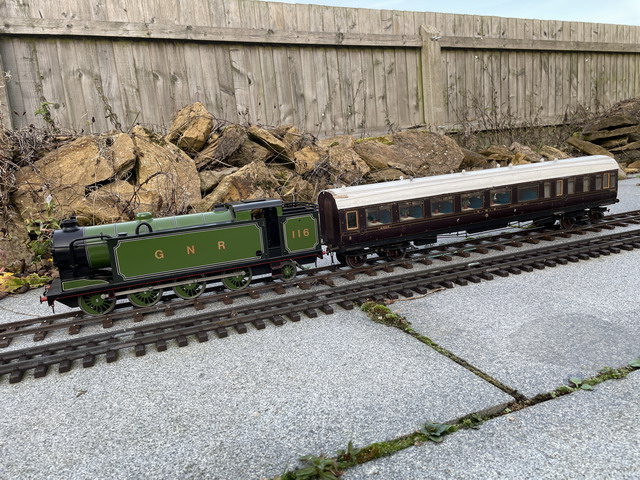
But some will wonder if the loco should be returned to Greenly's 0-6-6-0 form? While G2 0-6-0 mechanisms are unobtainable, an electric version could easily be made in 3D SLS Nylon printing along with the steamroller G2 wheels in Greenly's picture. Such a mechanism could be made to articulate properly and have tremendous power, perhaps completing the concept that Greenly pioneered so long ago.
Who knows ???
Henry Greenly's first Challenger - Part 2
March 2023Maybe you can guess the outcome ... or not? Over time I became steadily convinced that this unique model really is Greenly's original handiwork, and is indeed the very same one shown by him unfinished in "Models, Railways and Locomotives" back in December, 1911. I have to say that not everyone agrees with this identification, or with Greenly's claim that "I made this". Maybe another, even more original version will turn up. But for now, I'm satisfied that this is Greenly's original model, and strongly believe that he made it himself.
Various subsequent references to the model turned up - One showing it as a 'battery electric' version with a lead acid battery in the copious cab and bunker. This might explain the oversize form of the model. It even appears in Greenly's 'Model Electric Locomotives and Railways', published 1922. But always it is illustrated with the same unfinished photograph.
Once the identification became clear, so did the way ahead. The original 'Jupiter' mechanisms mentioned are long lost, quite likely returned by Greenly to his friend Bassett-Lowke. There was no intrinsic value in the 0-8-2 chassis that the model sat on and so the option of replacing it with modern electrically powered mechanisms was clear. No modifications to the model were needed because it had originally sat on articulated frames, as shown in Greenly's 1911 drawing, with the characteristic lozenge shaped cut out present in the model today.
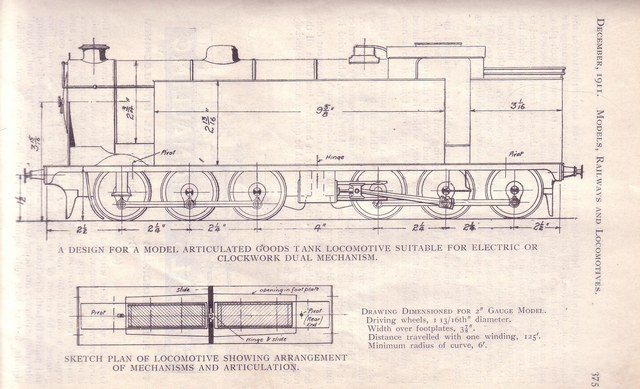
In the 21st Century, a brand new way to produce the new frames and mechanisms was available - a technology that Greenly could hardly have dreamed of - 3D printing. Using the original 1911 drawing, two sets of 0-6-0 frames were drawn up, together with gearboxes mounting modern '540' motors. Back in 1911 electric motors were being used in model locomotives, but were far from satisfactory because true 'permanent' magnets were still far in the future. Motors like the one illustrated in Greenly's original proposal (we know he never built this, because it would have meant cutting pieces out of the model) were hugely inefficient and prone to overheating. So the choice of modern motors with Neodmium magnets was clear. This meant that the model could be battery powered, using another modern innovation, the Lithium-ion battery.
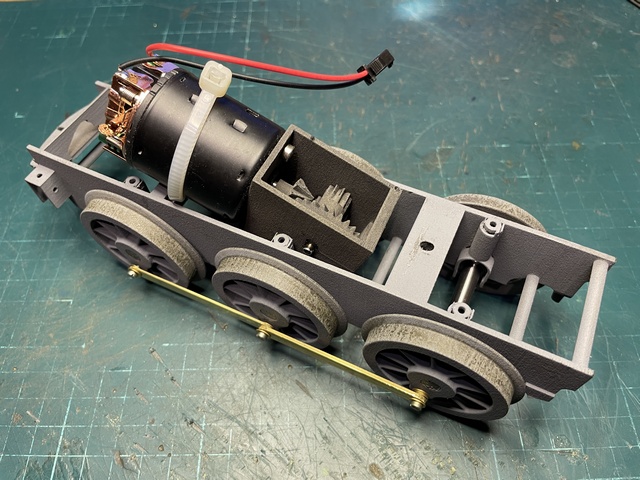
This chassis is based on the outline of Greenly's drawing and uses his articulation method. It is sprung using coil springs inside the cylinders on top of each horn guide and the axle boxes are formed by ball bearings. The chassis is printed in one piece in Nylon using a process called 'Selective Laser Sintering', or SLS, which fuses a nylon powder into the form that you see. As fused nylon it is very robust, impervious to liquid or chemical interference and has excellent long term stability. Geenly would have loved it.
The gears and wheels are all made in the same material. Only the axles and coupling rods are metal. The motor used (there are two of them in this locomotive) is a 'racing' version of the 540, chosen mecause it has large replaceable carbon brushes and is capable of great power - up to 1/4 HP if the electronic controller allowed it (it doesn't!). Power is supplied by two '26650' lithium polymer batteries, giving 5Ah at 8.4v, enough to run the loco for 2-3 Hours.
So here it is - Henry Greenly's 'Articulated Shunting Locomotive' as he perhaps envisaged it - the most powerful Gauge 2 locomotive ever made.
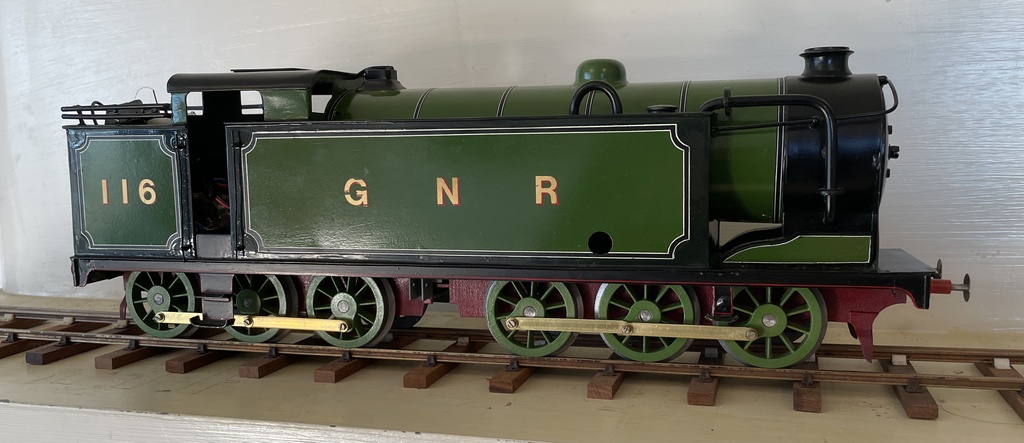
And just to prove the point, here it is at the head of a 40 wagon train on the Gauge 2 railway, certainly the largest train ever made up in Gauge 2 and pulled by a single locomotive.
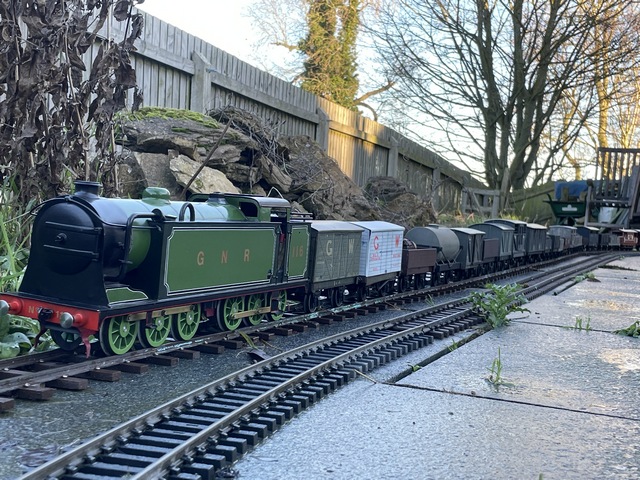
In October 2022 the Greenly Articulated Shunting Locomotive made it's first ever public appearance in Bicester, England running on the Gauge 2 layout, itself the first public appearance of a Gauge 2 layout with live steam in a very long time indeed. You can see it in action here.
I hope that the great man was smiling down on us!